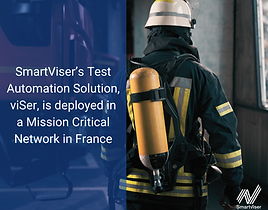
Push To Talk Performance
Push To Talk (PTT) evaluation and assessment on crucial KPIs for evaluating the systems efficiency and reliability
Overview of PTT Performance Test Automation Solution
Push-to-Talk (PTT) technology has evolved significantly, especially in mission-critical networks. This evolution includes transitioning from traditional TETRA systems to modern cellular networks.
The transition from TETRA to cellular networks for PTT in mission-critical communications marks a significant advancement, offering enhanced capabilities, broader coverage, and better integration of modern communication technologies. While there are challenges to overcome, the benefits of moving to LTE and 5G networks are substantial, providing a robust and future-proof solution for public safety and other mission-critical applications.
Push-to-Talk (PTT) technology is critical in various fields due to its unique capabilities and benefits:
-
Instant Communication
-
Group Communication
-
Availability as its now working over TETRA, Cellular and WiFi
-
Security

Challenges and solutions
Challenges to overcome include
-
Assess the launch readiness of new Mission Critical voice services and applications.
-
Test on different networks both live or in the lab using actual end-user devices for best evaluation of end-user experience.
-
Perform truly objective testing that uses POLQA algorithm to measure accurately the MOS score without requiring human listeners.
-
Ensure the Reliability and Stability of the application.
-
Verify performance metrics using objective testing methodologies.
-
Validate Network Compatibility ensuring roaming and handovers.
-
Battery Power Efficiency.
-
Compliance with Regulatory standards.
-
Testing on LTE and 5G networks.

How we solve them
-
Test on any chipset, any device Android, or iOS using end users' devices without rooting or jailbreaking.
-
Easy setup and scalable setup. No bulky equipment required.
-
Test any Push To Talk (PTT) Application.
-
Full end-to-end automation with scores on MO and MT.
-
Measure all the MCPTT Performance KPIs.
-
Enhanced data analytics to help visualize, drill down, and benchmark the data.
-
Unique Audio MOS scores are plotted on a map for ease of analysis.
Key Benefits of Voice Quality Testing
-
Saving lives: High-quality voice communication leads to better management of critical situations where clarity of communication is of top priority.
-
Quality Assurance and Confidence: Providers that ensure superior voice quality can be confident their products will work as expected.
-
Regulatory Compliance: Adhering to regulatory standards and benchmarks for voice quality is often mandatory.
-
Technical Assurance: Identifies and resolves issues related to network performance, device compatibility, and service integration.

Use cases

Mission Critical Networks
Ensuring reliability and stability of MCPTT
and compatibility with the network.

OEMs
Device Manufacturers need to ensure their device is working as expected with different MCPTT applications.

Infrastructure Providers
Ensure optimum performance of their infrastructure against MCX Networks, devices and applications.

MCPTT/PTV Vendors
Ensure the PTT/PTV application is thoroughly tested and benchmarked against several devices and infrastructures.

Governmental Agencies
Ensuring reliability and stability of MCPTT
and compatibility with the network.

Testing Labs
Testing as part of conformance and certification.
KPIs
SmartViser solutions for Audio Voice Quality support all the main KPIs for MCPTT/MCPTV
Some of the KPIs supported are:
-
MCPTT Access Time
-
The time between when an MCPTT user requests to speak and when this user gets a signal to start speaking not including confirmations from receiving users.
-
-
End-to-end MCPTT Access Time
-
The time between when an MCPTT user requests to speak and when this user gets a signal to start speaking including MCPTT call establishment acknowledgment.
-
-
Mouth-to-ear latency
-
The time between an utterance by the transmitting user, and the playback of the utterance at the receiving user’s speaker.
-
-
Late call entry time
-
The time to enter an ongoing MCPTT Group Call is measured from the time that a user decides to monitor such as MCPTT Group Call, to the time when the MCPTT UE’s speaker starts to play the audio.
-
-
Perceived voice/audio quality
-
ITU standard Perceptual Objective Listening Quality Assessment (POLQA) as defined in P.863.
-
Sample Reports from Analytics Studio

SmartViser Audio Access Time per call

SmartViser Call Services Latency per call

SmartViser Access Time Average for all calls

SmartViser Audio Access Time per call
In terms of applications the PTT Mission Critical Applications is widely used:
-
Public Safety and Emergency Services:
-
Police and Fire Departments: Essential for dispatching units, coordinating responses, and ensuring the safety of personnel.
-
Emergency Medical Services: Facilitates quick coordination and information sharing among medical responders.
-
-
Transportation and Logistics:
-
Fleet Management: Enables real-time communication with drivers, improving route management and delivery efficiency.
-
Public Transit: Supports coordination among transit operators, ensuring smooth operation and addressing issues promptly.
-
-
Construction and Utilities:
-
Site Coordination: Helps in managing on-site activities, coordinating between different teams, and ensuring safety protocols.
-
Utility Services: Facilitates communication among field workers, ensuring efficient maintenance and repair operations.
-
-
Manufacturing and Industry:
-
Plant Operations: Supports coordination on the factory floor, ensuring efficient production processes and addressing issues quickly.
-
Safety and Maintenance: Helps in maintaining safety protocols and coordinating maintenance activities.
-
PTT technology plays a crucial role in various sectors by enabling instant, reliable, and secure communication. Its applications span from public safety and transportation to healthcare and industry, proving its versatility and importance in modern communication infrastructure.
As technology advances, PTT continues to evolve, integrating with modern networks like LTE and 5G, further enhancing its capabilities and applications.


%20(2491%20x%20907%20px)%20(2).png)





